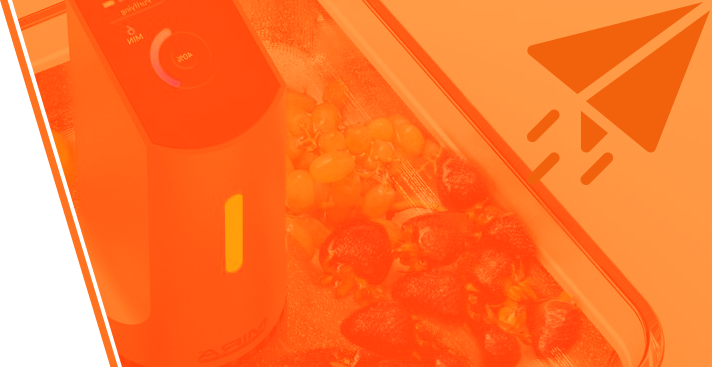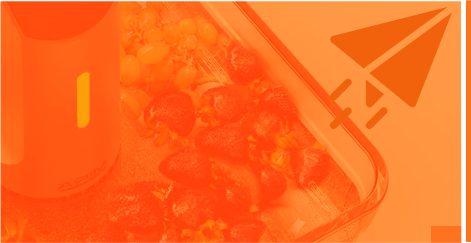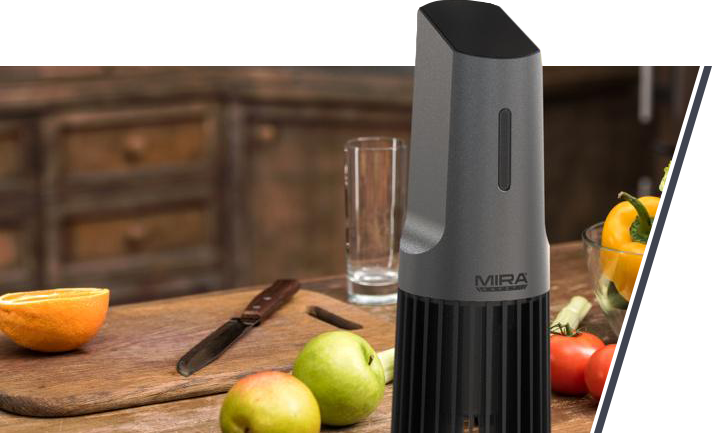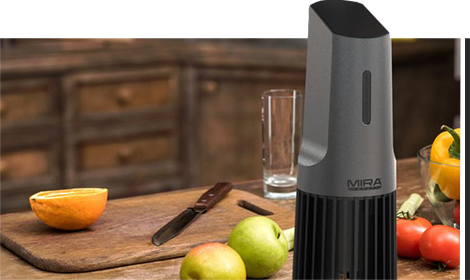"No root. No weed. No problem."
That's a slogan from Roundup, an herbicide brand under Monsanto-Bayer that guarantees "it's safer than table salt."
It's well known for killing pesky weeds at the source, so they never return. And it's all thanks to the primary ingredient, glyphosate, which has the highest global production.

(Image source: Image courtesy of Wikipedia)
However, it's also earned infamy as a "probable carcinogen" by the International Agency for Research on Cancer (IARC), an extension of the World Health Organization (WHO). And glyphosate is banned in over ten countries, including Mexico, Germany, and Saudia Arabia.
Yet the U.S. Environmental Protection Agency (EPA) does not consider glyphosate a threat. It continues to show up on the market and, unfortunately, on your dinner plate.
This secret "added ingredient" can have serious consequences for your family’s health.
So today, we’re looking at the risk factors, the lawsuits linked to the long-term effects, and how you can protect yourself and others from consumption/contact.
Table of Contents
-
01
Glyphosate: Not Exactly a Stranger
-
02
Friendly Neighborhood Herbicide or Potential Villain?
-
03
Roundup Takes the Stand, Again and Again
-
04
Protect Your Plate From Glyphosate
-
05
Conclusion
Glyphosate: Not Exactly a Stranger
If you have a backyard that needs lawn maintenance, then you're probably no stranger to glyphosate-based products like Roundup.

It’s a powerful weapon that annihilates weeds efficiently, right at the source, preventing its roots from drawing in the soil’s nutrients. And that’s it, no more weeds or excess foliage. It gets the job done, and that’s why it’s been doing so for more than 42 years.
Stauffer Chemical Co. first introduced glyphosate and patented it as a mineral chelator in 1964. Monsanto then took it over and pushed glyphosate as a nonselective herbicide, meaning it annihilates most plants at the root and prevents them from producing specific proteins needed for plant growth.
Farmers apply these products when harvesting grain crops such as wheat, oats, barley, beans, and more.
The way it's applied depends on the Roundup applicator, but the most common is the standard spray bottle used on broadleaf weeds or grasses. Other applicators use a continuous spray wand, a protective shield on the rod (to avoid indirect spraying), and a tank sprayer.
In 1996, Monsanto raised the stakes with its first batch of Roundup-Ready seeds or "terminator seeds" (named for their sterility) that began as genetically modified soybeans immune to glyphosate's weed-killing properties. So the pesticide would indiscriminately kill everything but these roundup-ready crops, allowing the soybeans to grow without interference, meaning controlled pests and better harvests.

(Image source: Image courtesy of Agriculture Consulting Service)
Since the seeds were sterile, farmers had to go back to Monsanto for another batch of Roundup-Ready seeds once the harvest ended. Those GMO seeds helped skyrocket the Roundup brand name, and to this day, Americans alone have used 1.8 million tons of the weed killer.
Consumers use Roundup on lawns, gardens, weeds in industrial areas, and on aquatic plants.
It’s not just Roundup either. In total, there are over 750 U.S. products containing glyphosate.
From your neighbor next door to the produce section of the local grocery store, this "stranger" wasn't so strange.
Friendly Neighborhood Herbicide or Potential Villain?
You might be starting to realize just how often you’re exposed to this particular pesticide.
Roundup-Ready GMO crops are found all over the U.S., and the spray itself, when applied, doesn't degrade quickly. In 2020 alone, the product had a 20-fold increase in usage.
Fortunately, it can't seep into your groundwater, but it does hold tightly to the soil (more on that later).
While Roundup is increasingly popular in America’s giant factory farms, other countries all over the world are taking steps to curb their exposure.
Austria was the first country in the EU to ban the weed killer in July 2019. Germany agreed to phase out glyphosate by 2023. And officially, the European Commission has approved the use of glyphosate in the European Union until December 15, 2022.
In 2015, the IARC researched the harmful effects of glyphosate and deduced that it was considered a “probable cancer-causing herbicide.”

(Image source: Image courtesy of GreenPal)
This announcement from the IARC did create a minor stir in the US. Each state created a change.org petition to request their governor ban or regulate glyphosate. But the response of the EPA was the same as Bayer-Monsanto: Roundup and glyphosate were not dangerous.
However, it was clear to U.S. consumers that Roundup was becoming increasingly popular. Approximately 90% of food products tested by the U.S. government had glyphosate in them.
The product can be accidentally consumed in a number of different ways. You could breathe it in when spraying your lawn, indirectly get the product on your skin, use the product and then smoke or eat without washing your hands, or brush your bare legs/arms against the sprayed foliage.
On top of that, all the GMO products in your grocery store—ranging from canola oil, corn, soybean, and cotton—also contain some quantity of the chemical.

(Image source: Image courtesy of Genetic Literacy Project)
Fortunately, there's much more awareness today. Several states in the U.S. have taken measures into their own hands and have restricted/banned the product in specific cities and counties. Here are some examples:
-

Alaska (1 of 7 states that control their pesticide policies)
-

Tuscan, Arizona
-

The majority of California (they are leading the charge against Roundup)
-

Boulder, Colorado
-

Miami, Florida (saw the effects on the environment/wildlife)
-

Chicago, Illinois
-

Carrboro, North Carolina
-

Cuyahoga County in Cleveland, Ohio
The list will only continue to grow as more lawsuits come in.
What does glyphosate do to humans?
According to the EPA, the short-term exposure effects of glyphosate are harmless.
And whether you're a child or an adult, the results have the same degree of irritants. They include:
-

Eye and skin irritations.
-

When inhaled, irritation to the nose and throat.
-

When consumed, burning in the mouth and throat, nausea, vomiting, and diarrhea.
Note: Even our beloved fur babies aren’t immune to the effects of herbicides. Pets that make direct contact with glyphosate have excessive drooling, vomiting, diarrhea, loss of appetite, and sleepiness.
Note: Even our beloved fur babies aren’t immune to the effects of herbicides. Pets that make direct contact with glyphosate have excessive drooling, vomiting, diarrhea, loss of appetite, and sleepiness.

(Image source: Image courtesy of Pet Health Network)
These warning labels are on all Roundup products; if exposed, they direct you to simple first aid procedures to remedy them. What isn't on the warning labels are the concerns most folks face today, and that's the potential long-term effects of Roundup.
Those who frequently worked with the product found they had symptoms that weren’t mentioned in any standard warnings.
They include: shortness of breath, wheezing and coughing, swelling of the lymph nodes, swelling and fluid accumulation or pain in the abdomen, sudden weight loss, fatigue, weakness, night sweats, chills, and a fever. These are all symptoms of non-Hodgkin's lymphoma (also known as NHL or "lymphoma"), the most common cancer linked to most Roundup lawsuits.

(Image source: Image courtesy of Greenberg & Bederman LLC)
Lymphoma is cancer that takes form within white blood cells called lymphocytes. It's found mainly in male adults (risk increasing with age), but women and children can get it too. It starts in the lymph nodes or any lymph tissue and can sometimes affect the skin. There are varying types of NHL, but it depends on the individual's lymphocytes (B-cells or T-cells), the maturity of the cells when they become cancerous, and more.
People at risk include those exposed to benzene or specific herbicides/insecticides (such as glyphosate), chemotherapy drugs, and particular medications associated with rheumatoid arthritis (such as methotrexate).
Many of these risks still have no exact factor that leads directly to NHL, which is a primary reason for the EPA's reluctance to accept the direct link between long-term glyphosate usage and lymphoma.
Scientists are still studying the adverse effects of increased glyphosate usage in the soil and aquatic foliage. Understanding how our herbicide and pesticide use affects the surrounding wildlife is essential.
The Effects of Glyphosate on the Environment

(Image source: Image courtesy of Marine Mammal Commission)
In a scientific study titled "Chronic Exposure to Glyphosate in Florida Manatee," published in March 2021, Florida manatees were persistently exposed to an herbicide with glyphosate, known as Roundup, on sugarcanes and aquatic weeds.
It found that more than half of all sampled Florida manatees had glyphosate in their plasma. A significant increase from 2009 to 2019.
These researchers discovered that Florida's waters (such as the Caloosahatchee and St. Lucie rivers) contained high quantities of glyphosate before and during the harvest of sugarcanes. The chronic use of Roundup only worsened their risk of kidney and liver damage. Scientists only found more glyphosate concentrations from the Florida Fish and Wildlife Conservation Commission, which used up to 10,000 kilograms per year to control aquatic weeds in Lake Okeechobee.
Because glyphosate is the most widely used herbicide, with about 280 million pounds a year used across 285 million acres (in agriculture), it's no wonder conservationists are worried about the wildlife of these areas going extinct.
Manatees are already at an all-time low population count, as they have to deal with getting caught in boat motors and not starving to death because of water pollution.
By destroying the wildlife around these areas, we're also damaging the soil and land that feeds them.
In another study by the University of Florida, they wrote on the trending and alarming increase in glyphosate-based products used for weed control. They admit glyphosate is nonvolatile and relatively stable. But what's most worrisome is how out of control the herbicide usage has become since Roundup grew in popularity among agricultural and industrial industries.
Here are three significant concerns environmental scientists have with Roundup:
1)Persistent Usage and Presence in the Environment
Returning to the concerns mentioned earlier about the manatees, the increased and customary usage of glyphosate has damaged plant life and foliage in nontarget areas. Scientists noticed indirect spraying and excess glyphosate runoff in waters that didn't even need the product.

(Image source: Image courtesy of EcoWatch)
Also, scientists noted that when a plant decayed or died, it contained lingering Roundup residue that remained within the soil. It was the same for the roots exudating glyphosate into the surrounding soil – it would still occur regardless if the plant was living or dead.
2)Effects on Crop Health
You would imagine using Roundup would lead to more significant, healthier crop results. But a research article from the Southwest Florida Research & Education Center found that excessive application sometimes leads to disease development in crops. One disease directly linked to glyphosate excess was Fusarium head blight (FHB or "scab") in crops that used up large acreages, such as wheat or corn. The fungus created from the diseased grain is known as deoxynivalenol and is considered dangerous to humans and domestic animals. The United States Department of Agriculture (USDA) ranks FHB as the WORST plant disease to hit the U.S. since the epidemics of the 1950s.
Another example of Roundup's effect on crop health is the 10% chance of "spray drift," meaning when someone mass sprays the product onto specific crops, there's a slight chance it also goes on crops that don't need it (e.g., soybean, cotton). When that spray drift hits these susceptible crops, they tend to become distorted when harvested. A perfect example is "cat-facing" tomatoes that, when disfigured (see below image), have a high chance of becoming infected with black mold rot.

(Image source: Image courtesy of Utah State University)
Lastly, these scientists noticed that dead weeds released glyphosate, which could absorb through the roots of growing citrus plants. After the absorbed glyphosate enters the plant's system, it quickly inhibits the growth of young growing tissue. Hence the Roundup slogan of attacking weeds where it hurts, right at the roots.
3)Interaction With Crop Nutrition
Recent evaluations showed that the chelating ability of glyphosate reduces the uptake and translocation of nutrients in crops that heavily rely on glyphosate for weed management. Especially for nontarget areas hit with spray drift or runoff Roundup, the roots of these crops would result in missing vital micronutrients and becoming more susceptible to disease.
Scientists concluded in this study that glyphosate hit the market with a tremendous impact on weed control and how we harvest crops today. Although it degrades quickly and is known to be "safer than table salt," it's evident that its continuous usage has only brought about negative results over the decades.

(Image source: Image courtesy of Ethical Consumer)
If its use was controlled and regulated, glyphosate would at least be safer. But it’s been widely abused, and use is only on the rise.
And due to a lack of top-down regulation, affected individuals are taking to civil court—and suing Bayer-Monsanto by the thousand.
Roundup Takes the Stand, Again and Again
There are still 30,000 glyphosate lawsuit cases that have yet to be resolved, including 4,000 in multidistrict litigation (grouped to address similar concerns) in California alone, and over 100,000 cases already settled.
In one case, a California school groundskeeper said he had been using Roundup for many years and sued because he thought it was the cause of his cancer. While the jury didn't feel there was a direct correlation, they also didn't believe Monsanto-Bayer did enough to warn the plaintiff of the cancer-inducing product. The jury awarded him $300 million.
Edwin Hardeman, age 70, used Roundup for 20 years, and finally, a federal jury announced that his exposure to Roundup was a substantial factor in causing his non-Hodgkin's lymphoma. The votes were unanimous, which led to a second trial to determine the amount he would receive in punitive damages. The jury returned a verdict of approximately $80 million, with punitive damages of $75 million. Judge Vince Chhabria ultimately awarded him a reduced $20 million.
Monsanto-Bayer has won its fair share of cases.
A child in California was diagnosed with Burkitt's lymphoma, and the jury ruled they could not see a substantial correlation between the weed-killing herbicide and the child's diagnosis.

(Image source: Image courtesy of TorHoerman Law)
Cases like those above keep coming up, one after the other.
Googling "glyphosate lawsuit" delivers 217,000 search results.
It’s a startling example of just how widespread the health consequences of glyphosate use have been.
But to win a lawsuit against Monsanto-Bayer for injuries, you would need to receive a diagnosis directly linked to glyphosate exposure.
Monsanto-Bayer has resolved $11 billion in cases, resulting in more than a year of negotiations and three consecutive losses for the company. The trials also resulted in a combined $2.424 billion jury verdicts for the plaintiffs.
In June 2022, the Ninth Circuit Court of Appeals decided that, in their opinion, the EPA should reconsider the conclusion that glyphosate or Roundup isn't harmful to humans or the environment.
Then, in July 2022, the 11th Circuit ruled that Bayer failed its consumers by not warning them adequately of Roundup's substantial risks.

(Image source: Image courtesy of The Business Journal)
Bayer's future promise to its consumers was that at the start of 2023, it would work toward replacing its glyphosate-based products in the U.S. residential Lawn & Garden market with new formulations that rely on alternative active ingredients.
Each lawsuit's combined efforts against glyphosate have produced a proper response and awareness that is spreading rapidly, and it's starting to influence the companies responsible.
But how can you keep this harmful chemical from showing up on your family’s plates?
Let’s take a look …
Going “Glyphosate-Free” in Your Kitchen
If you’re starting to wonder how you can keep Glyphosate and other industrial chemicals out of your kitchen, then you’re not alone.
Consumers across America are starting to realize the harmful health effects of GMO food products.
And no matter the future promises of Bayer, no matter how "quickly" states try to control or ban glyphosate usage, it's clear that we're already knee-deep in damages. Many products on your supermarket shelves have come in contact with the herbicide, and it's hard to specify what to avoid, what to do when it comes to food consumption, and how safe you are using Roundup products.
Even foods marked “organic” aren’t always safe.
First and foremost, it's essential to lessen and avoid further exposure to any glyphosate products. However, if it's part of your employment and you're required to handle it, here are the best ways to avoid it:

(Image source: Image courtesy of IFLScience)
Don't make direct contact with it. If you have a MIRA Safety CM-6M gas mask, it checks off most ways to avoid inhalation, consumption, and contact exposure from the neck up. You could also get safety glasses or goggles, but they need side view protection and don't 100% guarantee your safety.
Also, always use rubber gloves and never use open-toed shoes. Make sure you have thick socks, long-sleeved shirts, and long pants.
If possible, do your best to avoid places where the product is likely to be sprayed in copious amounts, such as industrial lawns or gardens or agriculture areas, such as seed plots. If you work in such a career as a groundskeeper or landscaper, ensure that you always have wearable protection. And if your job doesn't provide safety gear, make sure to get that access.
Now, what about the food you eat?
You might be starting to think about your pantry … and wondering how much of your pantry has glyphosate in foods or otherwise contaminated.
Below is a list of the WORST offenders for glyphosate contamination:
-
1)
Cooking Oil.
-
2)
Margarine.
-
3)
Biscuits.
-
4)
Baked Goods.
-
5)
Snack Bars
. -
6)
Cereal
. -
7)
Soda drinks.
Also, do your research BEFORE going to the grocery store so you know which GMO products you can remove from your shopping cart if your answer to exposure is avoidance.

(Image source: Image courtesy of Vox)
Here are some of the top glyphosate in foods:
-
1)
Any GMO products.
-
2)
Vegetable cooking oils (Canola oil).
-
3)
Bread.
-
4)
Corn.
-
5)
Sugar.
-
6)
Beer.
-
7)
Chickpeas and lentils.
Another tip in prevention is to eat various kinds of vegetables, fruits and dairy products that can counter the effects of glyphosate in foods. For example, eating sulfur-rich foods (such as organic eggs and cheese) balances against the herbicide's depletion of the body's sulfur and sulfate pathways. And probiotics (found in food items such as cheese, yogurt, apple cider vinegar, and kimchi) assist in maintaining a healthy gut filled with good bacteria. Keep in mind, glyphosate in foods functions as an antibiotic that will kill any bacteria (beneficial or not).
But what if you don’t want to give up on your favorite foods?
Well, you're in luck.
MIRA Safety's DTX-1 Oxidizing Food Detoxifier Meat, Fruit, and Vegetable Wash Machine

The MIRA Safety DTX-1 Food Detoxifier was specifically engineered to counter foodborne threats like glyphosate.
The truth is that 40% to 50% of ALL harmful substances primarily enter our bodies through food. The other 20% to 40% enters through our water. So, if you thought glyphosate was the only offender, you might want to check what other "secret ingredients" are hiding in your grocery bag.
It's simple to use, doesn't add MORE harmful agents (such as chemicals, solvents, cleaning agents, or additives) to your vegetables or fruits, and you don't have to give up your favorite food items.
This handheld device works by using ultrasonic waves and rapid oxidation to release and dissolve toxins to clean the water AND your added produce.
The LCD display allows you to navigate key features and select from four modes for detoxification. They include raw foods, thermal treatment, antiparasitic treatment, and household items.
That’s right, it even cleans your everyday household items, so you don't have to worry about carrying in any harmful herbicides or pesticides. It's hard to imagine that sometimes we carry home those toxic agents to our pets or kids. The DTX-1 reduces the risk entirely.
And before you ask, this product has a one-year warranty AND is made to last five years with standard usage. It's also 100% approved by labs in Switzerland and the EU. This product isn't just something you can grab off the shelves. We, specifically at MIRA Safety, wanted to provide you with something guaranteed and worthy of maintaining the best health for you and your family. We take it very seriously, and as you've read above, glyphosate and other herbicides/pesticides are no laughing matter.
While the world's constantly changing, so are the everyday items we use to maintain our homes. This product can actively avoid risks surrounding harmful contaminants that you and your family may overlook. And so, while we wait for changes to herbicide control from the U.S. federal government, the EPA, or even Bayer, maybe your home can already be in the future, using this prepared product.
Conclusion
Of course, this isn’t the first time that a mega-corporation has failed to tell the truth about their harmful products.
For years, the tobacco industry insisted that cigarettes were safe. They fought tooth-and-nail in courts, spending millions to preserve their profits … while their customers contracted cancer.
Bayer-Monsanto told us Glyphosate in foods was safer than table salt.
Now there are 30,000 ongoing lawsuits.
Its active ingredient, glyphosate, has been directly linked to non-Hodgkin's lymphoma by global health authorities.
For decades, it was a part of the GMO trend and, at one point, may have been considered "safe." But as it grew in excessive use, the federal government couldn't keep up to monitor it, and the EPA and Bayer continued to claim it harmless.
But the truth is obious.

(Image source: Image courtesy of GoodTo)
Organic products are becoming the healthier option, and scientific studies have helped us understand how harmful herbicides/pesticides can be to the environment, wildlife, and humans.
Today, with innovative technology and products such as the MIRA Safety DTX-1, we can take action in our own homes against those nasty pesticides, carcinogens, and other everyday threats. It proves more than ever that products such as the DTX-1 have become more of a necessity than a wishlist item.
The risks will always be present, but we can still move forward and take the best possible actions to make our homes and food safer.





